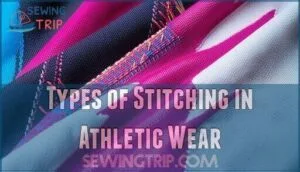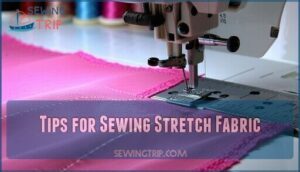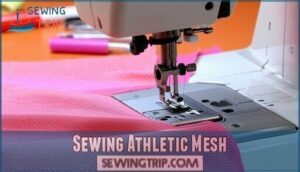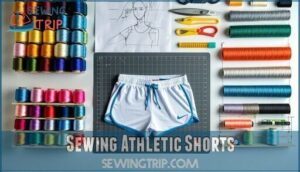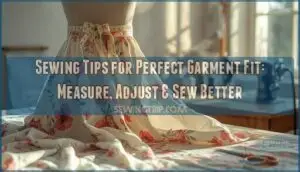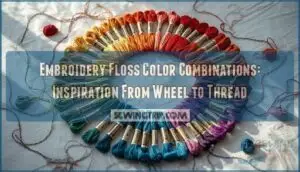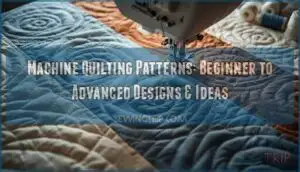This site is supported by our readers. We may earn a commission, at no cost to you, if you purchase through links.
 When you’re learning how to sew athletic material, start with a ballpoint needle and polyester thread—they’re your best friends for stretchy fabrics.
When you’re learning how to sew athletic material, start with a ballpoint needle and polyester thread—they’re your best friends for stretchy fabrics.
Use a zigzag stitch or serger to maintain flexibility, since straight stitches will snap when the fabric stretches.
Pre-wash your material to prevent shrinkage surprises later. Keep your tension loose; tight stitches create puckering that’ll make your seams look amateur.
A walking foot helps feed thick materials evenly through your machine. Test your settings on scraps first—athletic fabrics can be finicky.
The real game-changer lies in understanding which specialty techniques work best for different fabric weights and stretch percentages.
Table Of Contents
Key Takeaways
- Use the right tools from the start – You’ll need ballpoint needles and polyester thread to prevent snags and tears, plus a zigzag stitch setting that moves with stretchy fabrics instead of breaking like straight stitches do.
- Test everything on scraps first – You can’t fix tension problems or stitch disasters once they’re on your finished garment, so always practice your settings on leftover fabric before touching your actual project.
- Pre-wash your athletic fabrics – You don’t want your perfect-fitting activewear to shrink after the first wash, so treat your material the same way you’ll treat the finished garment.
- Keep your stitches flexible – You’re building clothes that need to stretch and move, so stick with zigzag, triple zigzag, or twin needle techniques that won’t snap when you bend, stretch, or exercise.
Understanding Athletic Material
What makes athletic material different from regular fabric? When you’re sewing athletic material, understanding your fabric’s DNA is vital.
Fiber composition determines how your stretch fabric behaves—polyester blends offer durability while spandex provides that essential fourway stretch.
Athletic fabrics are engineered athletes—respect their unique DNA and they’ll perform flawlessly under pressure.
Knit structure affects recovery, with jersey knits offering comfort and interlock** providing stability. Fabric weight impacts performance too.
Lightweight materials work perfectly for breathable tops, while heavier knits suit compression leggings.
Performance finishes like moisturewicking treatments aren’t just marketing—they actually pull sweat away from skin. Many brands now prioritize ethical sourcing, using recycled fibers without compromising performance.
Before cutting, test your material’s stretch in both directions. Pull a sample lengthwise and crosswise to understand its limits. This simple step prevents disappointment later when seams pop during wear.
Remember, athletic materials are engineered to move with your body—respect that engineering.
Types of Stitching in Athletic Wear
You’ll need specific stitch types that move with athletic fabrics while maintaining durability through repeated stretching and washing.
Understanding these stitching techniques guarantees your activewear maintains its shape, provides proper support, and withstands the demands of athletic activities, ensuring durability through repeated use.
Extra Seam Structure With Elastic
Understanding athletic fabric properties sets the foundation for mastering elastic integration. When sewing athletic fabric, elastic becomes your secret weapon for seam reinforcement.
Choose braided elastic for high-stress areas and clear elastic for lighter stabilizing seams. Mark quarter points on both elastic and fabric before stretching elastic while sewing.
Use zigzag stitches with 2.5-3mm length for ideal tension control. Understanding how to use specialty presser feet can further streamline this process.
Test elastic placement on scraps first, ensuring your seam structure maintains stretch without compromising durability. This strategic approach transforms ordinary stretch fabric sewing into professional-grade activewear construction.
Extra Stitching for a Clean Finished Look and Extra Stability
Why settle for homemade-looking activewear when professional finishes are within reach? Extra stitching transforms your athletic garments from amateur to elite-level quality. To guarantee garments withstand rigorous activity, testing stretch recovery is essential.
Add understitching for stable, clean inside seam finishes. This technique prevents facings from rolling outward while creating professional results.
- Understitch seam allowances in the direction of the facing using regular stitch length
- Press thoroughly before and after understitching for crisp edges
- Reinforce high-stress areas with multiple stitch rows for enhanced durability
Last but Not Least: Thread
Thread becomes your activewear’s backbone, so choose wisely.
Polyester thread for stretch fabric provides excellent durability, while woolly nylon offers superior flexibility.
Match your needle to thread weight for peak performance.
Proper thread tension prevents puckering and guarantees smooth seams.
Color matching creates professional results, and quality sewing threads maintain their strength through countless washes and workouts, which is crucial for peak performance.
Sewing Machine Needles
Your needle choice can make or break your athletic wear project.
Ballpoint needles are your best friend when sewing athletic fabric – they slide between fibers instead of piercing them, preventing those frustrating runs and snags.
For lightweight mesh, grab a 70/10 ballpoint needle.
Medium-weight compression fabrics need 80/12 to 90/14 sizes, while heavy-duty materials require 100/16 needles.
Stretch needles feature special scarf designs that prevent skipped stitches on elastic materials.
Jersey needles work perfectly for knit athletic wear with their slightly rounded tips.
Match your needle size to thread weight – mismatched combinations cause shredding or fabric damage.
Needle maintenance is vital for preventing damage.
Replace needles after 6-8 hours of continuous sewing or when they become dull.
A bent needle will ruin your fabric faster than you can say "workout gear."
Consider purchasing quality needles to guarantee the best results.
Keep your sewing machine running smoothly with proper needle types and regular replacements.
Basic Stitches for Sewing Athletic Material
Once you’ve selected the right needle, mastering your sewing stitches becomes the foundation for professional-looking activewear.
The zigzag stitch reigns supreme when sewing athletic fabric because it moves with your body’s every twist and turn.
Here’s your stitch arsenal for conquering stretch materials:
- Zigzag Stitch: Your go-to workhorse that flexes without breaking when sewing spandex and other stretch fabrics
- Triple Zigzag: Reinforces high-stress areas like shoulder seams while maintaining maximum stretch capacity
- Twin Needle Hem: Creates parallel zigzag rows for clean, professional-looking cuffs and waistbands
Skip the straight stitch entirely—it’ll snap faster than you can say "burpee."
Set your machine to 10-12 stitches per inch and test on fabric scraps first.
The overlock stitch works beautifully for seam finishing, while coverstitch and chainstitch excel at hemming.
Remember, your sewing stitches need to stretch as much as your fabric does during those intense workout sessions.
Many retailers offer specialty zigzag products for advanced sewing projects.
Tips for Sewing Stretch Fabric
Once you’ve mastered basic stitches, stretch fabric becomes your playground. Working with spandex and lycra requires specific techniques that’ll transform your sewing athletic wear game.
Start with ballpoint needles and quality polyester thread to prevent those annoying puckers that scream "homemade." For specialized tools, consider exploring options for stretch fabric projects.
**Choose stitches with give.
** Straight stitches snap under pressure, so embrace zigzag, lightning bolt, or decorative options that move with your fabric.
Mind the fabric grain—cutting on-grain prevents skewing disasters. Mark grainlines clearly before you cut.
When securing elastics at waists or ankles, use the 1:1 stretch technique for stability without restriction.
Test your stitch settings and tension settings on scraps first. Proper needle choice and seam finishes matter. Knit fabric sewing demands patience, but the results are worth it.
Sewing Athletic Mesh
Master sewing athletic mesh by focusing on proper needle selection and mesh stabilization techniques.
Choose ballpoint needles to prevent snagging the delicate fibers.
Make tension adjustments on your machine—reduce presser foot pressure to avoid stretching.
Cut single layers using rotary cutters for precision.
Employ narrow zigzag stitches or short straight stitches for flexible seams.
Pattern alterations may be needed to accommodate mesh’s unique properties.
Focus on professional seam finishes using overlock or serger methods.
These performance fabric sewing techniques guarantee your athletic material maintains its breathability while delivering professional results.
Sewing Athletic Shorts
Moving from mesh to shorts construction, you’ll discover that athletic shorts require specific techniques to achieve that perfect balance of comfort and performance.
Athletic wear sewing demands attention to detail, especially when working with performance fabric sewing materials that need to move with your body.
Your athletic shorts construction starts with smart fabric choices and proper pattern alignment.
Here’s what separates amateur attempts from professional-quality athletic apparel:
- Pocket construction using mesh or lightweight lining prevents bulk while maintaining breathability
- Liner options include built-in compression shorts or removable inserts for versatility
- Waistband types range from fold-over elastic to drawstring combinations for secure fit
- Hemming techniques using twin needles create professional edges that won’t bind
- Drawstring details require reinforced eyelets and quality cord for durability
- Seam placement should follow natural body lines to prevent chafing during movement
When sewing activewear shorts, remember that fit trumps fashion every time.
Tips for Sewing Thicker Material
Thick athletic materials can intimidate even experienced sewists, but they don’t have to derail your activewear projects.
When sewing thicker material, you’ll need strategic adjustments to achieve professional results without wrestling your sewing machine.
Essential modifications for heavyweight athletic wear sewing include:
- Needle size: Use heavy-duty needles (100/16 or larger) to penetrate dense fabric layers
- Walking foot: Guarantees even feeding and prevents fabric shifting during construction
- Tension adjustment: Balance thread tension to avoid puckering or thread breakage
- Seam allowance: Increase slightly to accommodate bulkier seams when sewing activewear
For ideal results, remember to adjust presser foot pressure as needed.
Frequently Asked Questions (FAQs)
How do you sew athletic wear?
Use ballpoint needles and zigzag stitches to prevent fabric damage.
Choose four-way stretch fabrics with 50% elasticity.
Test stitch tension on scraps first.
Employ polyester thread for durability and flexibility in seams.
How do I choose the right fabric for my activewear project?
Choose fabrics with minimum 50% four-way stretch for ideal movement. Look for moisture-wicking properties, breathable construction, and durable materials like spandex, lycra, or jersey knits that’ll withstand frequent washing and stretching.
What equipment do I need for sewing activewear?
Like a carpenter needs the right tools for precision work, you’ll need a sewing machine with stretch stitches, ballpoint needles, polyester thread, sharp scissors, and measuring tools to craft professional-quality activewear.
How many free sewing patterns for athletic wear?
Finding free sewing patterns for athletic wear can feel like striking gold.
You’ll discover dozens of options online through sewing blogs, pattern companies’ free sections, and crafting communities that share leggings, sports bras, and activewear designs.
How do you use stretch fabric for activewear?
Forget wrestling with stubborn fabrics that snap back like rubber bands.
You’ll need four-way stretch materials with 50% elasticity minimum.
Cut on-grain, use ballpoint needles, and sew with narrow zigzag stitches for seams that move.
Should you sew your own activewear?
Sewing your own activewear saves money and guarantees perfect fit.
You’ll control fabric quality, customize designs, and create pieces that move with your body.
It’s rewarding but requires stretch fabrics and specialized techniques.
How can I make my athletic garments more sweat-wicking and breathable?
Choose moisture-wicking fabrics like polyester blends with four-way stretch.
Select breathable materials with loose knits in high-sweat zones.
Test fabric’s airflow by holding it up to light—you’ll see how well air circulates through the weave to ensure breathable materials.
What interfacing or lining should I use for an athletic jacket or pants?
Like armor beneath a knight’s chainmail, interfacing transforms your athletic jacket into performance gear.
Skip traditional interfacing—use lightweight mesh or breathable stabilizers instead.
For pants, consider moisture-wicking tricot lining that moves with you.
How do I prevent fabric from curling while cutting?
Use weights or pattern clips instead of pins to secure your athletic fabric.
Press gently with a cool iron and rotary cutter for clean edges.
Store fabric flat and let it relax before cutting, this helps prevent distortion and ensures accurate measurements are taken for the best results.
Whats the best way to press stretch fabrics?
Pressing stretch fabrics is like taming a wild horse—you need gentle control.
Set your iron to low heat, use a pressing cloth, and lift rather than drag.
Steam lightly and let fabric cool completely before moving.
Conclusion
Mastering how to sew athletic material transforms your crafting capabilities completely.
You’ve discovered the secrets: ballpoint needles prevent snags, zigzag stitches maintain stretch, and proper tension eliminates puckering.
Remember to pre-wash fabrics, test settings on scraps, and use walking feet for thick materials.
These techniques guarantee your activewear projects look professional and perform flawlessly.
With practice, you’ll confidently tackle any athletic fabric, creating durable garments that move with your body and withstand intense workouts.
- https://knowingfabric.com/how-to-sew-with-stretchy-fabrics-the-ultimate-guide/
- https://madamsew.com/blogs/sewing-blog/sewing-with-stretch-fabrics-9-tips
- https://silverbobbin.com/how-to-sew-stretchy-fabric/
- https://www.gatheringthread.com/how-to-sew-stretch-fabric/
- https://www.contrado.com/blog/how-to-sew-stretchy-fabric/

